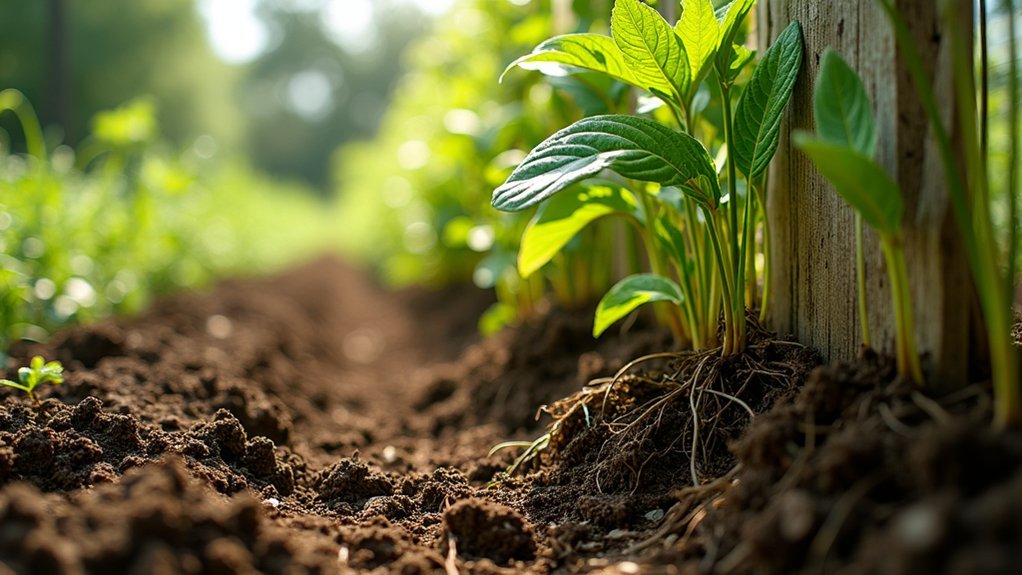Three root systems that considerably strengthen windbreak fences include deep taproots (like black walnut), fibrous networks, and complementary root patterns. Deep taproots provide exceptional stability against high winds by penetrating 10-15 feet into soil. Fibrous root systems prevent erosion by anchoring soil particles and can reduce wind erosion by up to 75%. You’ll achieve maximum protection by combining both systems in your windbreak design. The right root combination offers benefits far beyond what you can see above ground.
Deep Taproot Systems for Maximum Fence Stability

While designing an effective windbreak fence, the foundation of your success lies in the root system you select. Species with deep taproot systems, like black walnut and pecan, offer exceptional stability by penetrating 10-15 feet into soil layers.
A windbreak’s strength begins underground, where deep taproots create the foundation for lasting protection.
You’ll find these robust anchorage systems provide natural reinforcement against high winds, greatly reducing the risk of uprooting during severe weather. Beyond stability, these taproots improve soil health by accessing deep nutrients and moisture, enhancing overall plant vigor.
When you incorporate deep-rooted species into your windbreaks, you’ll create a resilient fence structure that requires minimal maintenance over time.
The benefits extend to your surrounding fields too—these windbreaks diminish wind speeds across agricultural areas, protecting crop growth and controlling erosion. Your investment in proper root systems pays dividends through stronger, longer-lasting windbreak protection.
Fibrous Root Networks That Prevent Soil Erosion
Unlike their deep-reaching counterparts, fibrous root systems create expansive underground networks that excel at preventing soil erosion around your windbreak fence.
These intricate systems anchor soil particles in place, reducing topsoil displacement and preserving essential nutrients. Your windbreaks with strong fibrous root systems can cut wind erosion by up to 75%, dramatically protecting your agricultural land.
The benefits of these networks include:
- Enhanced soil structure that improves water infiltration during heavy rainfall
- Increased soil moisture retention by reducing evaporation rates in arid regions
- Preserved soil health through stabilization of both horizontal and vertical soil layers
When you establish windbreaks with deep-rooted plants featuring fibrous root systems, you’re not just creating a barrier against wind—you’re building a thorough solution for long-term soil conservation.
Complementary Root Patterns for Year-Round Wind Protection

Building upon the strength of fibrous networks, complementary root patterns take windbreak protection to the next level through strategic plant diversity.
You’ll find that pairing deep taproot species with shallow fibrous roots creates an all-encompassing underground structure that enhances soil stability and reduces erosion.
When you combine black walnut’s anchoring taproots with eastern red cedar’s dense shallow roots, you’re creating a resilient soil structure that withstands harsh weather conditions.
This underground diversity improves water retention and nutrient absorption, supporting healthier vegetation regardless of season.
Your windbreaks will maintain effectiveness year-round when root systems complement each other.
Even during drought or extreme weather, these strategic combinations continue to mitigate wind speed and enhance crop growth.
Nature’s resilience shines when diverse root systems work together, maintaining protection when farmers need it most.
The intermingling roots form a living foundation that strengthens your entire windbreak fence system.
Frequently Asked Questions
What to Plant for a Wind Block?
Plant a mix of deep-rooted species like Black Hills Spruce and Eastern Red Cedar. You’ll benefit from adding fast-growing hybrid poplars, combining them with oaks and firs for ideal wind protection.
What Are Rows of Trees or Shrubs Used to Prevent Wind Erosion?
Rows of trees or shrubs used to prevent wind erosion are called windbreaks. You’ll find they’re highly effective at reducing wind speed by up to 50%, protecting your valuable topsoil from being blown away.
Which Plant Is Used as a Wind Breaker?
You’ll find Black Hills Spruce, Eastern Red Cedar, and Colorado Spruce commonly used as windbreakers. They’re effective due to their dense foliage, while hybrid poplars offer quick establishment if you’re seeking faster results.
What Are the Disadvantages of Windbreaks?
Windbreaks can compete with your crops for water and nutrients, create excessive shade, harbor pests, require significant investment, and potentially increase humidity. You’ll need proper management to avoid these drawbacks and maximize benefits.
In Summary
You’ve now discovered the three key root systems that can transform your windbreak fence from vulnerable to virtually immovable. By strategically planting species with deep taproots, fibrous networks, and complementary growth patterns, you’ll create a living anchor that strengthens with time. Don’t wait until after the next storm to implement these natural solutions—your property, livestock, and peace of mind will thank you.





Leave a Reply